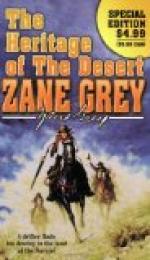On a sandy strip of bank the Navajos had halted. This was as far as they could go, for above the wall jutted out into the river. From here the head of the Canyon was not visible, and the roar of the rapids was accordingly lessened in volume. But even in this smooth water the river spoke a warning.
“The Navajos go in here and swim their mustangs across to that sand bar,” explained Naab. “The current helps when she’s high, and there’s a three-foot raise on now.”
“I can’t believe it possible. What danger they must run—those little mustangs!” exclaimed Hare.
“Danger? Yes, I suppose so,” replied Naab, as if it were a new idea. “My lad, the Mormons crossed here by the hundreds. Many were drowned. This trail and crossing were unknown except to Indians before the Mormon exodus.”
The mustangs had to be driven into the water. Scarbreast led, and his mustang, after many kicks and reluctant steps, went over his depth, wetting the stalwart chief to the waist. Bare-legged Indians waded in and urged their pack-ponies. Shouts, shrill cries, blows mingled with snorts and splashes.
Dave and George Naab in flat boats rowed slowly on the down-stream side of the Indians. Presently all the mustangs and ponies were in, the procession widening out in a triangle from Scarbreast, the leader. The pack-ponies appeared to swim better than the mounted mustangs, or else the packs of deer-pelts made them more buoyant. When one-third way across the head of the swimming train met the current, and the line of progress broke. Mustang after mustang swept down with a rapidity which showed the power of the current. Yet they swam steadily with flanks shining, tails sometimes afloat, sometimes under, noses up, and riders holding weapons aloft. But the pack-ponies labored when the current struck them, and whirling about, they held back the Indians who were leading them, and blocked those behind. The orderly procession of the start became a broken line, and then a rout. Here and there a Navajo slipped into the water and swam, leading his mustang; others pulled on pack-ponies and beat their mounts; strong-swimming mustangs forged ahead; weak ones hung back, and all obeyed the downward will of the current.
While Hare feared for the lives of some of the Navajos, and pitied the laden ponies, he could not but revel in the scene, in its vivid action and varying color, in the cries and shrill whoops of the Indians, and the snorts of the frightened mustangs, in Naab’s hoarse yells to his sons, and the ever-present menacing roar from around the bend. The wildness of it all, the necessity of peril and calm acceptance of it, stirred within Hare the call, the awakening, the spirit of the desert.
August Naab’s stentorian voice rolled out over the river. “Ho! Dave—the yellow pinto—pull him loose—George, back this way—there’s a pack slipping—down now, downstream, turn that straggler in—Dave, in that tangle—quick! There’s a boy drowning—his foot’s caught—he’s been kicked— Hurry! Hurry!— pull him in the boat— There’s a pony under— Too late, George, let that one go—let him go, I tell you!”




